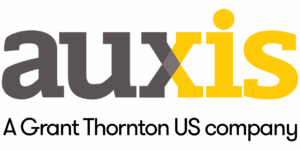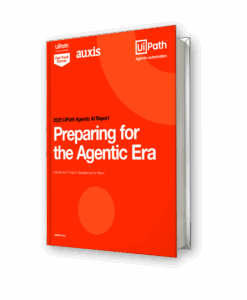In brief:
- The answer to “What is Agentic AI” sounds simple: It’s an emerging technology that blends large language models, machine learning, and automation to create a digital workforce of agents. But for many enterprise leaders, what that actually means for their business remains unclear.
- Agentic AI doesn’t replace traditional automation tools like RPA – it works alongside them, layering on top of existing automation and AI to orchestrate actions across systems and execute complex, multi-step workflows.
- The UiPath Agentic AI and automation platform, Maestro, is one of the few truly enterprise-grade orchestration solutions – uniting AI agents, robots, and humans to manage and execute complex business processes.
- To measure Agentic AI ROI, businesses should apply a structured approach like the Auxis AI Value Realization Framework, which outlines key phases of an AI and automation program and defines critical success factors for each stage.
As pressure mounts to maximize efficiency and lower operational costs in 2025, many organizations are turning to Agentic AI – the next-gen breakthrough in artificial intelligence. But despite the hype, confusion is high about what Agentic AI truly is, why it’s taking the business world by storm, and how to achieve transformative impact.
By now, everyone’s read the Cliff Notes version: Agentic AI empowers advanced software agents to learn, make decisions, and act independently, in concert with a governance model and human supervision (or escalations). As a result, AI agents can autonomously run workflows, adapt to changing conditions, and make intelligent real-time decisions – enabling businesses to reimagine how they manage complex processes and reach new heights of operational scalability and efficiency.
Companies are taking action:
- 90% of IT executives believe Agentic AI can significantly improve business processes (UiPath 2025 Agentic AI Report).
- 77% of organizations are planning investments (UiPath).
- 79% of senior executives say their companies are already using AI agents – and it’s paying off: 66% report higher productivity, while over half cite cost savings, faster decisions, and better customer experiences (PwC’s May 2025 AI Agent Survey).
Yet, most organizations remain unclear on how Agentic AI differs from earlier technologies like Robotic Process Automation (RPA), Generative AI (GenAI), and machine learning – especially when it comes to real-world applications, level of autonomy, and ROI.
Despite the technology’s promise, Gartner predicts that more than 40% of Agentic AI initiatives will be cancelled by the end of 2027 as projects driven by hype lead to poorly matched use cases, unclear business value, inadequate risk controls, and misunderstanding of the real cost and complexity of deploying agents at scale.
Agentic automation offers immense potential to transform productivity and efficiency – but success rests on disciplined execution and making careful, strategic decisions about how and where it is applied.
To bridge the knowledge gap, we’ve outlined answers to the most common questions our clients and prospects ask about Agentic AI. Read on to learn what is Agentic AI, how it works, why you should care, and how to harness its full potential for your business.
1. What is Agentic AI and how do AI agents work?
Touted as “Act Two” of automation, Agentic AI is an emerging technology that enables software agents to manage complex tasks, tools, and decision-making processes independently, with minor human supervision. These agents automate complex, unstructured processes that traditional automation can’t address with an unprecedented ability to analyze data, set goals, solve problems, learn from experience, and execute end-to-end, judgment-driven workflows.
Put simply, AI agents have a goal – and they can leverage tools like Generative AI large language models (LLMs), machine learning, and RPA to take action and achieve their goal without constant human input.
AI agents function by combining three important components:
- Sensors – such as email, chat interfaces, and APIs – act as the “eyes and ears” of an AI agent, gathering input such as text, voice, or API feeds to allow the agent to perceive its environment and understand context. For instance, if a vendor submits an inquiry about an invoice discrepancy via chat, the agent uses natural language processing (NLP) to interpret the message, identify intent, and extract key details like invoice number and type of issue.
- A reasoning engine analyzes data in the backend using LLMs, machine learning algorithms, planning engines, and other powerful AI tools to detect trends, make predictions, and generate actionable outputs. This enables the AI to move beyond surface-level responses and make complex, data-driven decisions based on patterns and probabilities.
In the case of the vendor’s invoice inquiry, the reasoning engine checks backend systems like the ERP or invoice management platform by querying relevant APIs. Based on predefined rules, learned behavior, and the contextual data collected, the agent decides whether it can resolve the issue or must escalate it to a human in the loop. For this vendor, the agent determines a revised issue is needed. - The agent drives action by directing actuators – often software robots like RPA bots and APIs – to execute specific tasks. Acting on its own decisions, the agent seamlessly coordinates bots’ actions such as sending personalized messages, updating dashboards, or handling transactions across systems.
To resolve the vendor inquiry, the agent instructs an RPA bot to update the system with the right information, generates a corrected invoice, and sends a chat response to inform the vendor – completing the workflow without human intervention.
2. How is Agentic AI changing automation?
AI agents are transforming automation as we know it – and that’s no exaggeration. Unlike traditional AI and automation, which focuses on isolated, rule-based tasks, Agentic AI enables end-to-end workflow automation that adapts to changing inputs, collaborates with people and systems, and intelligently integrates technologies like GenAI (LLMs), RPA, and APIs.
Think of it like this: an AI agent’s workflow is like one actor following a script, agentic automation is the full production, orchestrating multiple scripts and actors to deliver a seamless business outcome.
Agentic automation workflows break down complex, unstructured assignments into key functional components that allow AI agents to plan, adapt, and execute tasks intelligently:
1. Data collection & integration
A data management agent gathers real-time information from multiple sources like ERP systems, sales platforms, and external data feeds. Using LLMs and NLP, it interprets and integrates structured and unstructured inputs to form a unified dataset.
2. Data processing & analysis
A data analysis agent applies machine learning and NLP to identify trends, patterns, and anomalies. GenAI enhances this step by generating predictive insights, helping the agentic system plan next steps and simulate potential outcomes.
3. Decision-making & task adjustment
Decision-making forms the core of agentic workflows. Agents combine rules-based logic with adaptive algorithms to make context-aware decisions and adjust actions based on new data or evolving conditions.
4. Task execution & orchestration
Agents execute decisions by triggering actions through APIs, RPA bots, and enterprise applications. Orchestration ensures that each step happens in the right sequence across systems and stakeholders.
5. Continuous learning and optimization
AI agents continuously ingest new data, learning from outcomes to refine processes over time. This enables the system to handle greater complexity, adapt to business changes, and improve efficiency.
Throughout the workflow, agentic automation remains dynamic and responsive – able to pivot in real time to unexpected events and changing business conditions, ensuring continuity, accuracy, and optimal decision-making. While capable of operating autonomously across most tasks, agentic systems are designed with built-in safeguards, limiting their authority on high-impact decisions that require human judgment, such as preapproving a home loan. This balance between autonomy and oversight ensures both efficiency and accountability.
So, how does all this apply to the real world? Here’s how an agentic automation workflow could function in Procure-to-Pay (P2P):
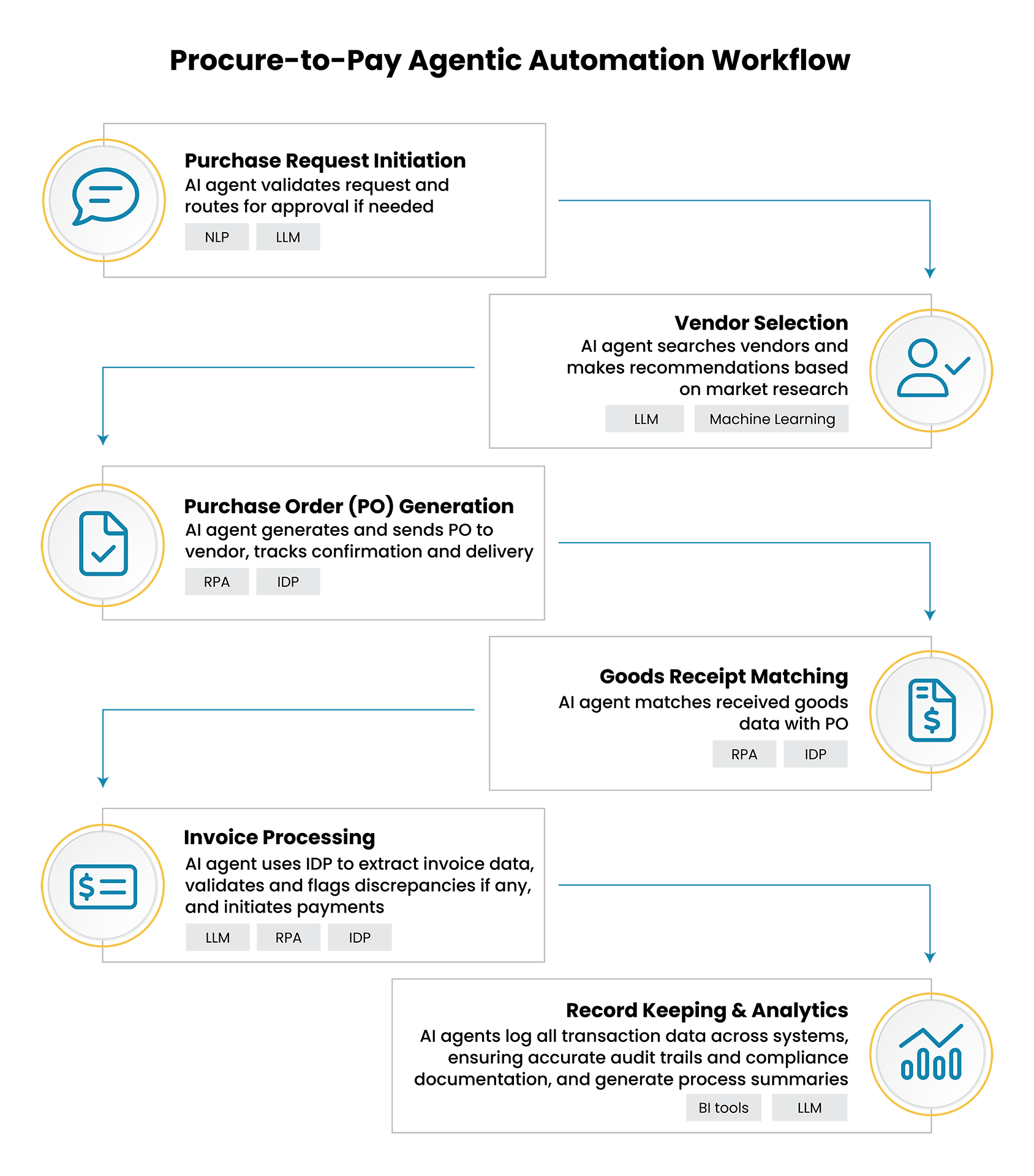
3. I’m already using RPA – so what’s the difference between RPA vs. Agentic AI? Will agentic automation eventually replace RPA?
Let’s be clear: Agentic AI is not a new iteration or replacement of RPA. Rather, it is a tool that enterprises can layer over RPA and other automation and AI technologies to execute actions and complete workflows with minimal human intervention.
RPA, around since the early 2000s, excels at automating repetitive, rule-based tasks like data entry, invoice processing, and system reconciliations across enterprise applications. Its biggest drawback: it struggles with unstructured data and can’t adapt to dynamic, exception-heavy scenarios – making it less effective for processes that require judgment or flexibility.
Agentic AI enhances RPA with intelligence and adaptability – acting as the “brain” in an automated workflow while directing RPA as the “muscle” for executing actions.
A major limitation of RPA is its sensitivity to change: bots inevitably break when faced with process exceptions like code or user interface (UI) changes, requiring manual intervention to reconfigure them.
Agentic AI solves this challenge by understanding context and adapting to changes in the environment that would previously cause bots to fail. By autonomously updating workflows or bot parameters in real time, agents keep automation running smoothly without interruption.
Together, agents and RPA enable smarter, end-to-end automation that drives efficiency, scalability, and innovation across your enterprise.
4. How will Agentic AI enhance my existing AI automation program?
Over the years, businesses have been increasing investments in building out AI and automation capabilities across their enterprise applications, adding RPA, Intelligent Document Processing (IDP), AI-enhanced Business Intelligence, Conversational AI, Generative AI, and more to build process efficiency and unlock greater agility, scalability, and data-driven decision-making across business functions.
Agentic AI presents the first real opportunity to autonomously orchestrate these siloed technologies, harnessing their fragmented capabilities into cohesive, automated business operations.
When powered by an orchestration platform like UiPath, Agentic AI gains the ability to intelligently coordinate actions across systems, teams, and technologies – turning isolated tasks into seamless, end-to-end workflows. It can select the right tools for each task, orchestrate entire workflows, and oversee execution – minimizing manual effort and freeing human teams to focus on higher-value work.
Even for advanced technologies like Generative AI and predictive analytics, Agentic AI acts as the central orchestrator – integrating their strengths into intelligent, goal-driven workflows. For instance, agentic orchestration can coordinate a marketing campaign: directing GenAI to create personalized marketing content; determining the optimal audience, timing, and channels; and deploying RPA bots to distribute content and track results.
The bottom line: Agentic AI offers the ability to automate complex, unstructured processes that were previously beyond the reach of automation – amplifying both efficiency and business value.
5. When should I use Agentic AI vs. Generative AI?
It is not about choosing Agentic AI vs. Generative AI, it’s about combining the power of GenAI’s intelligence with agentic’s ability to execute unattended automation to drive real business impact. While today GenAI is predominantly used as a virtual assistant or chatbot – producing language-based output like content creation, summarization, or translation – Agentic AI takes it a step further by embedding GenAI into autonomous workflows.
In other words, Generative AI creates intelligent outputs – Agentic AI puts them to work.
AI agents determine when, where, and how to apply isolated outputs within real-world workflows to drive actions, automate appropriate decisions, and deliver measurable business results.
6. Will Agentic AI replace chatbots and virtual assistants?
In this case, the real question is not AI agent vs. chatbot, but how quickly your business can leverage Agentic AI to redefine them.
Traditional rule-based chatbots have long frustrated users with their inability to understand context, handle exceptions, or process unstructured data. Even GenAI-powered assistants, while more conversational, can experience inaccuracies and hallucinations – posing business risk.
Agentic AI changes the game. It combines natural language understanding, decision making, and autonomous action across systems to go far beyond answering common questions: it can check order statuses, issue refunds, escalate when needed, update backend systems, and trigger workflows, all through a conversational interface that learns from every interaction.
It further combats AI hallucinations by providing context, structure, and oversight that guides how LLMs are used in real-world workflows.
Gartner predicts Agentic AI will autonomously resolve 80% of common customer service issues by 2029, cutting operational costs by 30% and making traditional chatbot models outdated for most business-critical use cases.
7. I’m hearing a lot of buzz about the UiPath Agentic AI and automation platform. Why is it different from other products on the market?
While major providers like OpenAI, Microsoft, Google, and Anthropic offer Agentic AI tools, deploying standalone agents in isolation rarely delivers the enterprise value leaders expect. Without orchestration, these agents often introduce new problems – tech sprawl, rising costs, fragmented efforts, and limited scalability – undermining the very efficiency they’re meant to create.
Orchestration is the missing link. It serves as the coordination layer that enables AI agents, RPA bots, GenAI models, enterprise systems, and human input to work together as one intelligent, end-to-end automation engine.
“Without orchestration, there is no Agentic AI.”
Source: UiPath CEO Daniel Dines, 2025 AI & Automation Trends Report
UiPath delivers smooth orchestration through a mature, enterprise-ready platform that goes far beyond the AI capabilities of most agentic AI systems on the market.
While most solutions offer standalone agents or depend on third-party integrations, UiPath’s agentic automation is natively built into a unified business automation platform that combines RPA, IDP, process mining, API automation, Communications Mining, AI governance, and more. As a result, agents gain direct access to powerful automation capabilities, supporting effective orchestration by eliminating the need for complex integrations while reducing costs.

At the root of UiPath’s agentic capabilities are its UiPath Maestro and Agent Builder products.
UiPath Maestro
The UiPath Maestro agentic orchestration platform is one of the only true enterprise-grade orchestration solutions available today. It combines autonomous decision-making with seamless execution – bringing together AI agents, automation bots, and people to run complex business processes across departments and existing enterprise systems.
Other stand-out capabilities of UiPath Maestro include:
- AI Agent collaboration: Agents can intelligently divide and conquer across multi-step processes that span departments and systems like Order-to-Cash (O2C) or customer onboarding.
- Exception handling: Agents manage exception paths, decision making, and escalations, minimizing the need for human-in-the-loop (HITL) support and increasing automation resiliency.
- Governance and control: Centralized observability and policy enforcement enables embedding of guardrails, policies, and governance rules into agent behavior and workflow execution, reducing hallucination risk and ensuring safe scaling of agentic automation.
- Enterprise-grade integrations: Leverages UiPath’s robust ecosystem (RPA, IDP, Communications Mining, etc.) and native connectors to leading enterprise apps to build a unique, extensive, enterprise-ready foundation.
- No vendor lock-in: Leverages UiPath’s integrations with third-party artificial intelligence systems like OpenAI and Azure, enabling enterprises to choose the best solution for each process without getting locked into a single model.
- Continuous improvement: Fact-based process monitoring offers real-time data to identify bottlenecks and opportunities and proactively improve agents and processes over time.
UiPath Agent Builder
UiPath’s Agent Builder complements Maestro by empowering teams to create and deploy specialized AI agents without complex prompt engineering. Stand-out features include:
- Context-grounded memory architecture ensures agents only retrieve and use context-specific knowledge from governed, permissioned data sources.
- Low-code interface makes building agents intuitive and scalable.
- Eliminates the challenging, manual prompt engineering required for Generative AI. Instead of writing, testing, and fine-tuning prompts for each task, businesses can design AI agents with structured goals, contextual understanding, defined tools, reasoning paths, and memory. These agents dynamically generate and adapt instructions and queries for the LLM based on real-time context and task progression, ensuring its outputs are aligned with business needs. This also allows agents to automate complex workflows completely without requiring people to craft prompts for every scenario.
- HITL-ready for seamless human collaboration when needed.
- Built-in accuracy and quality controls ensure consistent and reliable production performance.
8. How do I identify and prioritize the best agentic automation opportunities?
In the rush to adopt AI, excited stakeholders often implement in silos – failing to plan a clear, strategic roadmap aligned to business goals. The result: investment in “nice-to-have” pilots that don’t move the needle for the organization.
Defining your end goal at the start of your Agentic AI program is an essential first step to identifying opportunities that truly add value – ensuring you solve the right problems and drive meaningful outcomes.
Strategic planning also helps pinpoint use cases where Agentic AI excels, such as:
- Processes that need more than rule-based logic – requiring real-time decisions, handling ambiguity, or adapting dynamically.
- Processes automated with RPA that are heavily dependent on human oversight.
- Areas where manual effort leads to frequent or costly errors.
- Workflows that span teams, departments, or disconnected systems.
Maintaining a continuous opportunity pipeline is another essential step, preventing the momentum of your Agentic AI initiative from stalling. Establish a simple, repeatable process for gathering ideas – holding regular touchpoints with business stakeholders to surface emerging challenges and automation needs. Periodic deep-dive assessments will help ensure a strong, vetted backlog of opportunities.
Equally important is how you evaluate those ideas. Using a Prioritization Matrix enables you to score and rank opportunities based on factors important to your organization like impact, feasibility, and alignment to business goals – ensuring your resources go toward the initiatives with the highest Agentic AI ROI and fastest time-to-value.
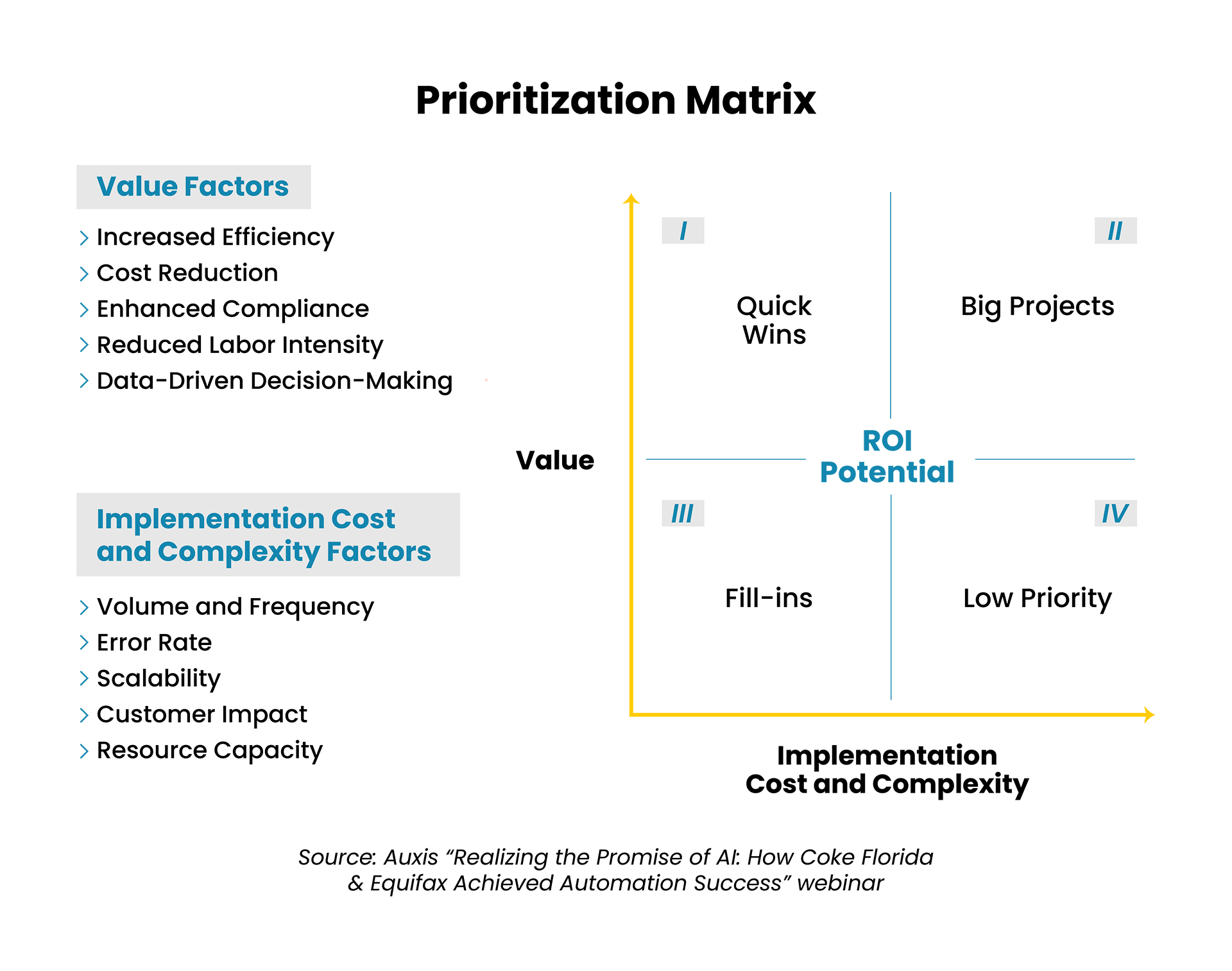
9. What kind of ROI can I expect from Agentic AI, and how does it compare to traditional automation investments?
Businesses are bullish on the returns they expect from Agentic AI:
62% of companies expect more than 100% ROI from Agentic AI investments. The average expected return: an astounding 171% on investment.
Source: 2025 Agentic AI Survey conducted by Wakefield Research
This far surpasses the typical ROI seen from traditional automation, which mainly delivers value by cutting labor costs and minimizing errors. Measuring agentic’s ROI solely through labor savings would be shortsighted.
By automating judgment-based workflows that traditionally require human intervention, Agentic AI delivers measurable gains in productivity, speed, and accuracy. Business leaders expect AI agents to automate and accelerate as many as 50% of routine tasks, according to the Wakefield study – and Gartner predicts at least 15% of day-to-day work decisions will be made autonomously through Agentic AI by 2028.
Agentic automation also improves scalability and customer experience, while freeing employees to focus on higher-value work.
The bottom line: When implemented strategically, companies can expect faster time-to-value, reduced operational costs, and higher process throughput.
Key metrics for measuring impact include gains in process efficiency, accuracy and quality, turnaround times, employee productivity, business outcomes, customer experience, scalability, and time to value. Benefits stretch across industries, unlocking even advanced processes requiring sought-after, specialized talent for automation.
To accurately measure Agentic AI ROI, businesses should adopt a structured approach like the Auxis AI Value Realization Framework, which outlines the essential phases of an AI and automation program and highlights the key success factors for each stage.
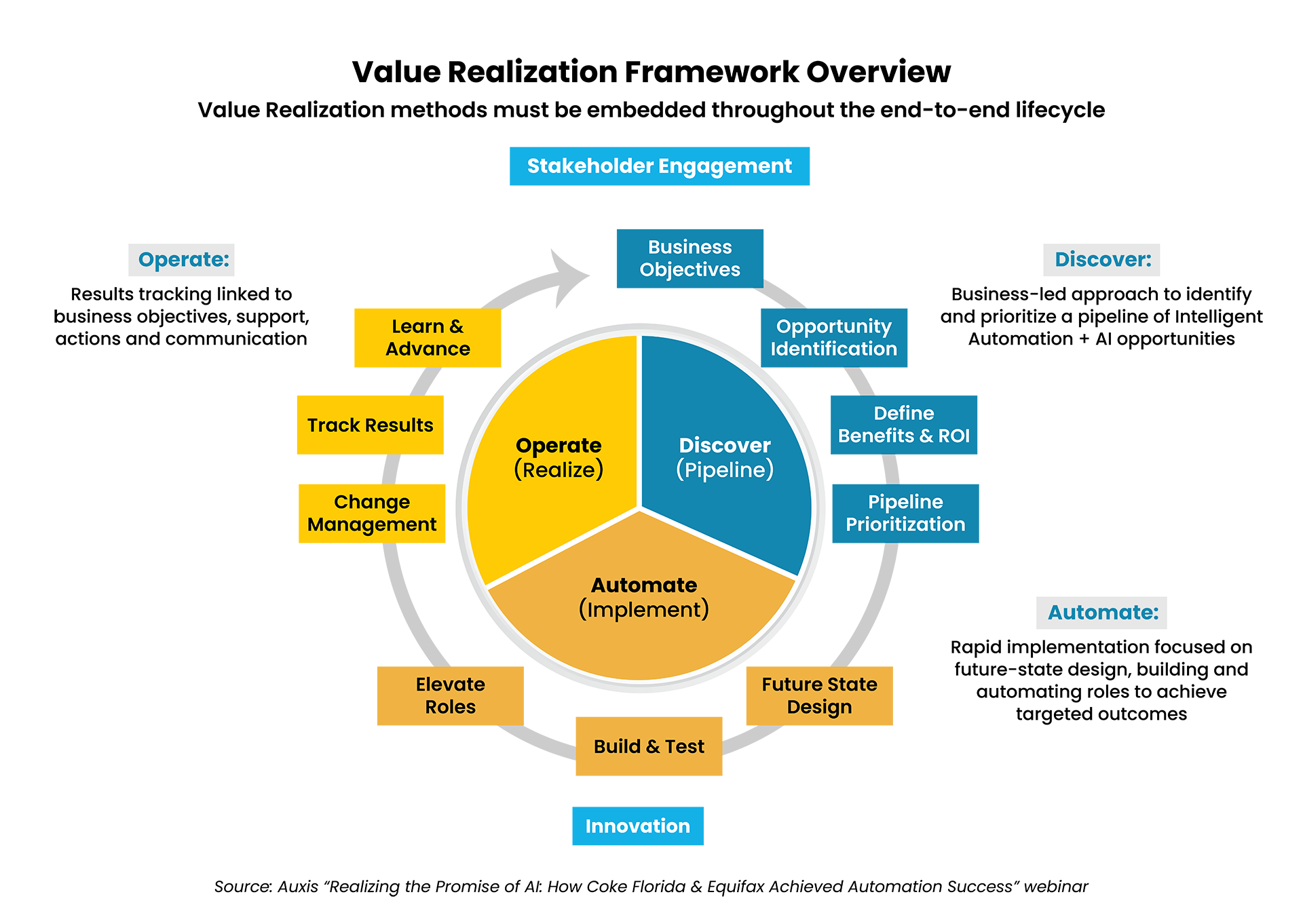
But keep this in mind: While 75% of businesses rank AI as a top investment priority, only 25% see significant value (BCG’s 2025 Closing the AI Impact Gap report). The biggest reasons? Lack of technical skills, difficulty proving ROI, and an inability to identify high-impact use cases, according to survey respondents at a recent Auxis AI webinar.
Unlocking the full potential of Agentic AI requires more than plugging agents into existing workflows. It calls for reimagining those workflows from the ground up – with agents at the core.
Partnering with a top-quality AI and automation partner is key to sustainable Agentic AI success – bringing the talent, tools, and expertise to accelerate AI-driven transformation, identify the best opportunities, reduce risk, and ensure value realization at every stage.
Why Auxis: Fast track your Agentic AI program
Agentic AI is considered one of the most disruptive innovations of our time.
“Agentic AI is not just a step in the evolution of automation; it is a breakthrough capability that will become a competitive necessity. Early adopters will gain a substantial advantage – but success requires a strategic and experimental approach.”
Source: Forrester Principal Analyst Rowan Curran, 2025 Agentic AI is the Next Frontier report
Getting Agentic AI right is critical for enterprises looking to stay relevant in an AI-driven future. But unlocking its full potential means reimagining how work gets done – redesigning processes, shifting human roles, and building agent-centric processes from the ground up.
Most organizations lack the in-house expertise to navigate this transformation. An experienced Agentic AI implementation partner can fill this critical gap – bringing the technical skills and strategic insight needed to drive AI transformation that creates meaningful business change.
Auxis, recognized among the select group of UiPath Agentic Automation Fast Track Partners, is uniquely positioned to help organizations harness the power of Agentic AI. The winner of UiPath’s 2024 Foundational Americas Partner of the Year award and a UiPath Platinum Partner, Auxis comes to the table with a proven ability to place AI and automation at the foundation of business innovation and success.
Combining technical excellence with nearly 30 years of business transformation experience, Auxis’ tailored solutions align with UiPath’s powerful agentic automation capabilities to help enterprises lead in innovation and achieve measurable results – while staying agile as AI technology and business demand continue to evolve at a rapid pace.
Want to learn more about how Auxis can help you harness the power of Agentic AI and automation to transform your business operations? Schedule a consultation with our AI automation experts today! Or, visit our resource center for AI tips, strategies, and success stories.
